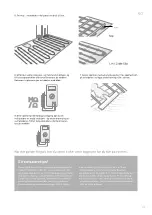
11
EN
Thank you for choosing Ebeco. We hope you will be happy
with your underfloor heating system for many years to come.
For the guarantee to apply, the product must be installed
and used as described in this manual. It is therefore
important that you read the manual.
If you have any questions, please contact us at Ebeco.
Call 031-707 75 50 or send an email to
[email protected]. You'll find more information at ebeco.se.
Welcome!
The heating cable is laid on floor constructions of concrete,
plaster or chipboard and must then be screeded with a
suitable levelling compound.
When applying screed on EPS concrete/cement, a
reinforcement mesh is required in between as a spacer
before the heating cable is laid.
On uninsulated concrete floors against the ground,
additional insulation is always recommended. Also, that the
heating is not switched off completely during the summer to
counteract moisture rising.
Cable Kit/Cableflex can be installed under tiles and natural
stone floors, wood and laminate floors and linoleum.
When screeding, the heating cable must be laid in a minimum
screed layer with a suitable levelling compound as follows:
Tile/natural stone floor 5 mm
Wood/laminate flooring, 10 mm
Linoleum 15 mm
See the applicable industry regulations for exact instruc-
tions regarding floor construction, screeding, sealing layers,
tiling, jointing etc. Please contact your dealer for answers to
specific questions.
Subflooring
Flooring materials
Heating cable
Recommended output
For screed
11 W/m, c/c 7–15 cm
Max
Recommendations and Max. output depending on criteria and needs:
The underfloor heating system is a high voltage system and
must thus be installed according to applicable regulations
by an authorised electrician. For the guarantee to apply, the
guarantee certificate must be correctly and completely filled
in, and signed by an authorised electrician.
May only be installed indoors.
• The heating cable must not be cut. Furthermore, it may
neither be crossed nor installed with spacing of less than
5 cm.
• The connection cable may be cut.
• The thermostat's sensor cable may be cut.
• The cable must be measured for resistance and insulation
as per the instructions. Document the values in our web
app, Garantera Ebeco, or in the guarantee certificate.
• Either a diagram or photo of the cable routing must be
documented.
• The sign
Heating Cable Installed
must be posted at the
main junction box.
• Heating must be regulated with Ebeco's EB-Therm
thermostats.
• The system must be connected to 230 V via a 30-mA earth
fault circuit breaker.
• The heating cable must not be run under stationary
furnishings, such as kitchen counters, closets, inner walls, etc.
because this produces elevated temperatures.
• In wet rooms, the heating cable must be run under a sealing
layer.
• Wait 4 weeks after applying screed before turning on the heat.
This gives the screed time to dry properly.
• In rooms with wooden floors the
Room and floor thermostat
function must always be used.
• When laying on reinforcement mesh, the cable must be laid on
the top of the reinforcement mesh.
• The maximum permissible heat resistance of the floor
material is 0.16 m² K/W.
Important
Floor material
Regulation
Subflooring
Tile/natural stone Max
160 W/m²
Room/Floor Concrete
Max 160 W/m²
Wood/laminate/lino-
leum Max 75 W/m²
Room +
floor
Combustible
Max 120 W/m²
In wooden subfloor
Max 80 W/m²
The output requirement of the room is governed by how well
insulated it is, its air circulation and outdoor temperature.
Industry guidelines for wood/laminate and linoleum on
underfloor heating
General conditions: The maximum permissible surface tem-
perature is 27°C. This also applies under carpets and furniture.
Coverage:
Note that with all covering of wood/laminate and linoleum
floors laid on underfloor heating, there is a risk:
• Of overtemperature in the floor
• That the temperature in the room becomes too low
Coverings include: carpets, beds without ventilated bases,
bookshelves with fully-covering bottom, kitchen cabinets etc.












































